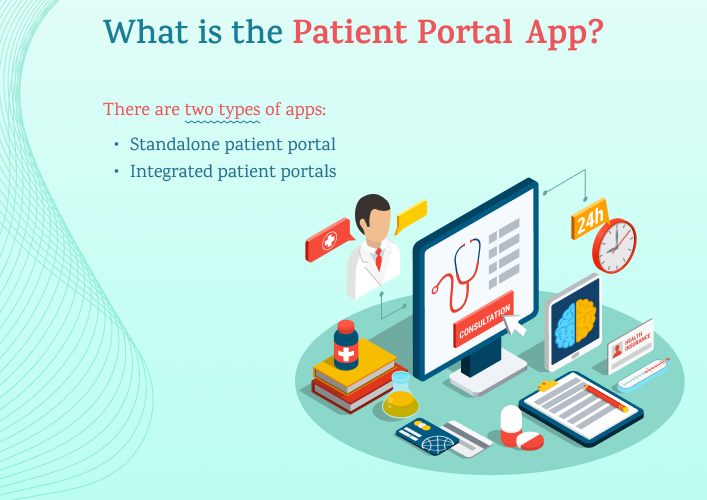What is the Patient Portal App?

Medical records, patient profiles, health billing management, healthcare treatment histories, and other related data may all be accessed via a patient portal app, which is a web-based and/or mobile solution. Building a patient portal may help people take better care of themselves, learn more about their health, and better communicate with their doctors. A patient engagement app provides time and energy savings for patients while also benefiting healthcare providers. Patients can access their healthcare records, including appointments, registration, and billing.
- Standalone patient portal: The usefulness of standalone medical portals is limited. They often excel at a single task, such as checking lab results or scheduling appointments. EMR (Electronic Medical Record), EHR (Electronic Health Record), and HMS (Hospital Management System) are just a few examples. Due to its low cost, this gateway type is ideal for independently run healthcare facilities such as clinics and laboratories. Because of their more basic design and fewer features, they need less time and money to create. In addition, scaling problems may arise when a company expands.
- Integrated patient portals: In most cases, electronic health record (EHR) or electronic medical record (EMR) systems and practice management software come hand-in-hand with patient portals. This kind of portal provides direct access to a healthcare provider’s patient database and a plethora of other features and services. This form of patient portal development requires more time and money. As a result, it requires more money upfront to build, but it benefits you in the long run.
What are the features to add to the Patient Portal?
Patient Registration
It is crucial to offer a quick and painless sign-up procedure. Patients can fill out the form so that doctors are better able to keep track of their treatment, medications, and health records. The profiles of the patients will be updated accordingly. Patients may register using any of the following methods: email, phone, or social media. Multi-factor authentication or biometric capabilities (such as fingerprint recognition) should be considered for securing individual accounts.
Patient data management
The creation of a patient portal app relies heavily on this function. Individual patient data should be accessible via online medical portals. Electronic health records (EHRs), insurance management, laboratory test results, billing history, medication plans, etc. are just some of the details that can be accessed by both physicians and patients using this functionality.
Appointment scheduling
Patients should be able to make appointments with their doctors after checking that doctor’s availability. Users get confirmation via email or SMS after they have chosen a time window.
Prescription management
Having a telemedicine solution built into your patient portal is a must. Patients typically need easy access to medication refills due to continuing therapy and recurrent medical care. Patients should be able to get their prescriptions for medications over the Internet.
Secure encrypted messaging
Patients should also have the option of receiving individualized advice from doctors via secure messaging. This may be done with the help of a live chat function or an AI-driven chatbot that is trained to answer frequently asked inquiries. This capability is helpful for managing chronic diseases and dealing with small concerns.
Online payments
Patients may pay for their medical care, the platform owner can earn a fee, and doctors can be compensated for their time and effort. Payment gateways like Stripe, PayPal, and GPay are the most efficient methods to accept online payments. However, modern data regulation and security standards must be used while designing a bespoke system service. Working with a competent software development business that can guide you to a proper implementation of the functionality is the best option here.
Conclusion
To sum up, the creation of a patient portal app is an essential part of healthcare since it improves patient participation, communication, and access to data. Several crucial stages must be taken before development can begin, such as requirements definition, interface design, security implementation, and EHR integration. Healthcare providers should make patient portal app development a top priority to enhance the quality of care provided to patients and increase the effectiveness of their operations.
FAQs
Describe the patient portal app
Why do healthcare organizations need patient portal apps?
What are the key features of a patient portal app?
How can patient portal apps improve patient care?
How can healthcare organizations ensure the security of patient portal apps?
Ravi Bhojani is the Chief Marketing Officer (CMO) at Alian Software, where he spearheads the company’s marketing strategies and drives its brand presence in the competitive IT services landscape. With over a decade of experience in the technology and marketing sectors, Ravi has consistently demonstrated his ability to blend innovative marketing techniques with deep industry knowledge to deliver outstanding results.